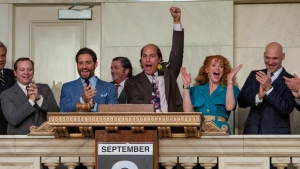Jan 26, 2017
'Gold' explores Bre-X scandal through Hollywood’s lens

Two decades have passed since the peak of the Bre-X gold mining scandal. And yet, many Canadians still remember the remarkable story as if it was yesterday.
Calgary-based Bre-X’s rapid rise from penny stock to $6-billion valuation captured the investment world’s attention, only to see investors quickly wiped out by the fraud. Add in the questionable death of Bre-X Geologist Michael de Guzman (ruled a suicide) and the story has always seemed more incredible than some Hollywood plot lines.
So, sure enough, the time has come for the film industry to find inspiration in Bre-X.
Gold, starring Matthew McConaughey, opens in movie theatres on Friday. Some of the film is based on the Bre-X scandal, although the characters and companies in the story are all fictional. Screenwriters John Zinman and Patrick Massett are best known for their work on television shows like The Blacklist and Friday Night Lights. But when they stumbled across the Bre-X story, they felt compelled to write a film script.
Below is a transcript from BNN’s Q&A with John Zinman:
What prompted your interest in the Bre-X story?

Several years ago, Patrick [Massett] was watching a TV documentary on the Bre-X scandal. He called to tell me about the story, so I checked it out. We both were completely hooked. We were certain there must be three or four projects in development in Hollywood.
When we started searching around, nobody had even heard about Bre-X. In the U.S., we don’t often look beyond our own borders. But Patrick and I felt the story had so much cinematic appeal. Think of adventurous films like The Treasure of the Sierra Madre, and add in a bit of "Death of a Salesman".
When we initially started talking about writing a script, we were primarily working on TV projects. We felt it was worth taking a shot, so we decided to write it on spec. It kind of relaunched our film careers, so we got a bit of gold out of it as well!
This film weaves together a fictional storyline with some of the main themes from the Bre-X scandal. How come?
We wanted to stay true to the idea, but we didn’t want to do a biopic or a re-tell the Bre-X story, which is quite complex and probably best told as a documentary. At the heart of this story is Kenny Wells, the character played by Matthew McConaughey. Kenny’s character is based on former Bre-X CEO David Walsh. The character is a down-on-his-luck guy, who seems to have his dreams come through, against all odds. In reading about Walsh, what we took away was that he never felt he got the respect he felt he deserved. There just seemed to be this powerful drive to have other people see him the way he wanted to be seen. That’s a trap all of us can fall into. There’s a lovability and sadness to the character, similar to [Death of a Salesman character] Willy Loman and this need to be the ‘Big man.’
We also wanted to focus on the greed, as the larger mining industry tried to squeeze out Walsh. That David and Goliath story was certainly appealing.
The mining company in the film is called Washoe Mining. Was there anything stopping you from using the Bre-X name?
There wasn’t really any legal impediment. The film’s financial backers just erred on the side of caution.

Matthew McConaughey ate cheeseburgers for months, to pack on pounds and more closely resemble Walsh. Was he who you envisioned playing the character of Kenny Wells?
Initially, we thought of actors who had put on weight in previous roles, like George Clooney in Syriana. But after Matthew’s incredible transformations in films like Mud and Dallas Buyers Club, it was as if a light bulb went off. And he turned out to be phenomenal.
Bre-X was a Calgary-based company. Why did you base the fictional company Washoe Mining in Reno?
For good or bad (and mostly for bad), that was based on the myopia of the United States. We felt this movie was going to require a good-sized budget. Our feeling was that resetting the story in Reno and New York (rather than Calgary and Toronto) would increase the potential box office and appeal more to film financiers. When people talk about the American dream, I think they are largely thinking of the United States’ brand of capitalism, even though this is based on a Canadian story.
When Bre-X collapsed, many blamed Bay Street as much as they blamed Bre-X. What were you hoping to achieve with the Wall Street portion of the film?
Everyone was culpable. With Bre-X, the opportunity was too big. It was just too spectacular. Everyone wanted it to be true. The only logical explanation I could find in our research was that everyone just got caught up in the exuberance. And that’s human nature. We saw that in the U.S. housing bubble before the financial crisis. There’s even a line in the script which references back to Tulip mania in the mid-1600s.
How do you think audiences will connect with this film, given the current economic and political environment?
We started writing this after the financial crisis. Kenny Wells is a very entertaining character. And people can probably identify with someone scraping up his last few pennies to strike gold. I think we are in a political and economic climate that has left some people frustrated and scared. And that makes a character like Kenny Wells very relatable to a lot of people.





